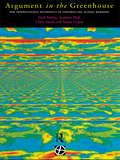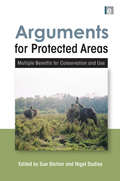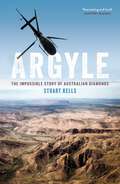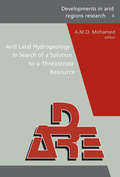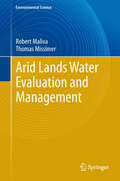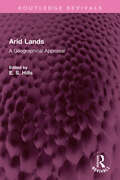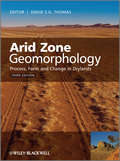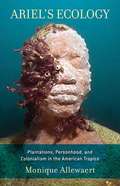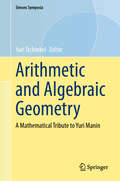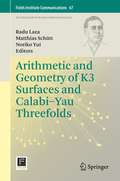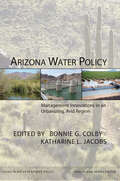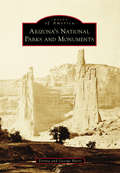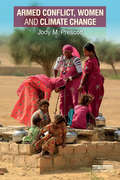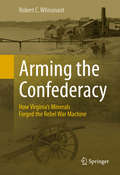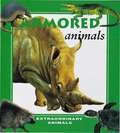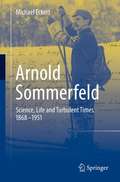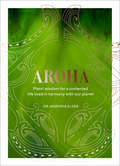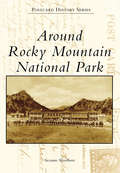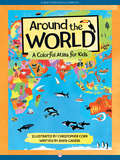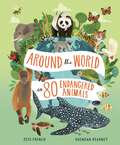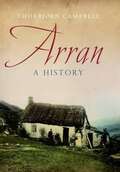- Table View
- List View
Argument in the Greenhouse: The International Economics of Controlling Global Warming (Global Environmental Change Ser.)
by Stephen Hall Clare Smith Sujata Gupta Nick MabeyHow can greenhouse gases be controlled and reduced? Will it be in time? This book adds a significant new contribution to the crucial climate change/global warming debate. Incorporating the key political and legal considerations into `real world' applied economic analysis, the authors provide a unique focus on the wider political economy of the problem. All the key issues of controlling climate change (costs, timing and degree of stabilisation, ecological taxt reform, developing countries, and evolution of international agreements), are placed firmly within the current legal and political context, with state-of-the-art economic techniques introduced to analyse different policy proposals. Covering both the developing and developed world, this book identifies important new policies to foster effective agreements on eissions and prevent global warming - realistic policies, likely to receive support at both international and domestic levels. be in time? This book adds a significant new contribution to the crucial climate change/global warming debate. Incorporating the key political and legal considerations into 'real world' applied economic analysis, the book's authors provide a unique focus on the wider political economy of the problem. All the key issues of controlling climate change (costs, timing and degree of stabilisation, ecological tax reform, developing countries and evolution of international agreements), are placed firmly within the current legal and political economy context, with state-of-the-art economic techniques introduced to analyse different policy proposals. Covering both the developing and developed world, this book identifies important new policies to foster effective agreements on emmissions and prevent global warming - realistic policies which are likely to receive support at both international and domestic levels.
Arguments for Protected Areas: Multiple Benefits for Conservation and Use
by Nigel Dudley Sue StoltonMost protected areas (e.g.national parks and nature reserves) have been created to protect wildlife and land- and seascape values. They currently cover over 13% of the world's land surface, around 12% of marine coastal areas and 4% of the marine shelf. Retaining and expanding these areas in the future will depend on showing their wider benefits for society. This book provides a concise and persuasive overview of the values of protected areas. Contributing authors from over fifty countries examine a wide range of values that are maintained in protected areas, including food, water and materials; health; tourism; cultural and spiritual values; and buffering capacity against climate change and natural disasters. The book also considers the role of protected areas in poverty reduction strategies, their relationship with traditional and indigenous people and in fostering conflict resolution through peace parks initiatives. The chapters draw on a series of authoritative reports published by WWF over recent years under the 'Arguments for Protection' banner, in association with various partners, and on additional research carried out especially for the volume. It analyses the opportunities and limitations of protected areas for supplying the various values along with practical advice for planners and managers about maximising benefits. It provides an important contribution to the debate about the role of protected areas in conservation and other aspects of natural resource management and human livelihoods. Published with WWF
Argyle: The Impossible Story of Australian Diamonds
by Stuart KellsThe remote Kimberley region of Western Australia has a rich history and unique geography. In the 1960s De Beers, the world's largest diamond company, sent gem-hunters to the area but they came away empty-handed. It was a vast region to survey, and they'd overlooked something vital. A few years later, a team of Australian geologists with a tiny budget searched for even tinier mineral clues. Those clues led them to the earth's largest diamond deposit and the world's richest source of rare pink diamonds. Based on in-depth research and interviews - including with Alan King Jones, Bill Leslie and 'the father of Australian diamonds', Ewen Tyler - Argyle: The Impossible Story of Australian Diamonds details the almost overwhelming challenges with realising a diamond mining venture in Australia, shows how these obstacles were overcome, and explores the mine's impact and legacy.
Arid Land Hydrogeology: Proceedings of the Third Joint UAE-Japan Symposium on Sustainable GCC Environment and Water Resources (EWR2006), 28 - 30 January 2006, Abu Dhabi, UAE (Volume IV in DARE series) (Developments in Arid Regions Research Series)
by A.M.O. MohamedThere are many urgent problems in arid land hydrogeology and it is these issues which are tackled in this volume on desert environments. The UAE-Japan symposia provide a venue for the exchange of expertise, confronting such problems as purification, usage and management of groundwater, the assessment and protection of sustainable water resources, a
Arid Lands Water Evaluation and Management (Environmental Science and Engineering)
by Robert Maliva Thomas MissimerA large part of the global population lives in arid lands which have low rainfall and often lack the water required for sustainable population and economic growth. This book presents a comprehensive description of the hydrogeology and hydrologic processes at work in arid lands. It describes the techniques that can be used to assess and manage the water resources of these areas with an emphasis on groundwater resources, including recent advances in hydrologic evaluation and the differences between how aquifer systems behave in arid lands versus more humid areas. Water management techniques are described and summarized to show how a more comprehensive approach to water management is required in these areas, including the need to be aware of cultural sensitivities and conditions unique to many arid regions. The integration of existing resources with the addition of new water sources, such as desalination of brackish water and seawater, along with reusing treated wastewater, will be required to meet future water supply needs. Also, changing climatic conditions will force water management systems to be more robust so that future water supply demands can be met as droughts become more intense and rainfall events become more intense. A range of water management techniques are described and discussed in order to illustrate the methods for integrating these measures within the context of arid lands conditions.
Arid Lands: A Geographical Appriasal (Routledge Revivals)
by E. S. HillsIn 1951 UNESCO launched an Arid Zone Programme with the object of promoting research into arid regions from every relevant scientific point of view. This book, originally published in 1966, represents the range of research undertaken and gives a general conspectus of arid zone geography. 17 authors from 8 countries contributed and the book deals comprehensively with all the main areas, with specific examples used to illustrate arguments. There are chapters on meteorology, geology, geomorphology, botany and zoology and almost 50% of the book is devoted to man’s activities: irrigation and agriculture; industry; animal breeding and human survival in the desert
Arid Zone Geomorphology
by David S. ThomasThe new edition of Arid Zone Geomorphology aims to encapsulate the advances that have been made in recent years in the investigation and explanation of landforms and geomorphological processes in drylands. Building on the success of the previous two editions, the Third Edition has been completely revised and updated to reflect the latest developments in the field. Whilst this latest edition will remain a comprehensive reference to the subject, the book has been restructured to include regional case studies throughout to enhance student understanding and is clearly defined into five distinct sections; Firstly, the book introduces the reader to Large Scale Controls and Variability in Drylands and then moves on to consider Surface Processes and Characteristics; The Work of Water, The Work of the Wind. The book concludes with a section on Living with Dryland Geomorphology that includes a chapter on geomorphological hazards and the human impact on these environments.Once again, recognised world experts in the field have been invited to contribute chapters in order to present a comprehensive and up-to-date overview of current knowledge about the processes shaping the landscape of deserts and arid regions. In order to broaden the appeal of the Third Edition, the book has been reduced in extent by 100 pages and the Regional chapters have been omitted in favour of the inclusion of key regional case studies throughout the book. The Editor is also considering the inclusion of a supplementary website that could include further images, problems and case studies.
Ariel's Ecology: Plantations, Personhood, and Colonialism in the American Tropics
by Monique AllewaertWhat happens if we abandon the assumption that a person is a discrete, world-making agent who acts on and creates place? This, Monique Allewaert contends, is precisely what occurred on eighteenth-century American plantations, where labor practices and ecological particularities threatened the literal and conceptual boundaries that separated persons from the natural world. Integrating political philosophy and ecocriticism with literary analysis, Ariel's Ecology explores the forms of personhood that developed out of New World plantations, from Georgia and Florida through Jamaica to Haiti and extending into colonial metropoles such as Philadelphia. Allewaert's examination of the writings of naturalists, novelists, and poets; the oral stories of Africans in the diaspora; and Afro-American fetish artifacts shows that persons in American plantation spaces were pulled into a web of environmental stresses, ranging from humidity to the demand for sugar. This in turn gave rise to modes of personhood explicitly attuned to human beings' interrelation with nonhuman forces in a process we might call ecological. Certainly the possibility that colonial life revokes human agency haunts works from Shakespeare's Tempest and Montesquieu's Spirit of the Laws to Spivak's theories of subalternity. In Allewaert's interpretation, the transformation of colonial subjectivity into ecological personhood is not a nightmare; it is, rather, a mode of existence until now only glimmering in Che Guevara's dictum that postcolonial resistance is synonymous with "perfect knowledge of the ground. "
Arithmetic and Algebraic Geometry: A Mathematical Tribute to Yuri Manin (Simons Symposia)
by Yuri TschinkelThis book is a tribute to the memory of Yuri Ivanovich Manin, who passed away on January 7, 2023. Manin was one of the giants of modern mathematics. His work covered a wide range of fields, including logic, number theory, geometry, mathematical physics, theoretical computer science, and linguistics. The contributions collected here are on topics close to his life-long passion: arithmetic and algebraic geometry.
Arithmetic and Geometry of K3 Surfaces and Calabi–Yau Threefolds (Fields Institute Communications #67)
by Matthias Schütt Radu Laza Noriko YuiIn recent years, research in K3 surfaces and Calabi-Yau varieties has seen spectacular progress from both arithmetic and geometric points of view, which in turn continues to have a huge influence and impact in theoretical physics--in particular, in string theory. The workshop on Arithmetic and Geometry of K3 surfaces and Calabi-Yau threefolds, held at the Fields Institute (August 16-25, 2011), aimed to give a state-of-the-art survey of these new developments. This proceedings volume includes a representative sampling of the broad range of topics covered by the workshop. While the subjects range from arithmetic geometry through algebraic geometry and differential geometry to mathematical physics, the papers are naturally related by the common theme of Calabi-Yau varieties. With the big variety of branches of mathematics and mathematical physics touched upon, this area reveals many deep connections between subjects previously considered unrelated. Unlike most other conferences, the 2011 Calabi-Yau workshop started with 3 days of introductory lectures. A selection of 4 of these lectures is included in this volume. These lectures can be used as a starting point for the graduate students and other junior researchers, or as a guide to the subject.
Arizona Water Policy: Management Innovations in an Urbanizing, Arid Region (Issues in Water Resource Policy)
by Bonnie G. Colby and Katharine L. JacobsThe central challenge for Arizona and many other arid regions in the world is keeping a sustainable water supply in the face of rapid population growth and other competing demands. This book highlights new approaches that Arizona has pioneered for managing its water needs. The state has burgeoning urban areas, large agricultural regions, water dependent habitats for endangered fish and wildlife, and a growing demand for water-based recreation. A multi-year drought and climate-related variability in water supply complicate the intense competition for water. Written by well-known Arizona water experts, the essays in this book address these issues from academic, professional, and policy perspectives that include economics, climatology, law, and engineering. Among the innovations explored in the book is Arizona‘s Groundwater Management Act. Arizona is not alone in its challenges. As one of the seven states in the Colorado River Basin that depend heavily on the river, Arizona must cooperate, and sometimes compete, with other state, tribal, and federal governments. One institution that furthers regional cooperation is the water bank, which encourages groundwater recharge of surplus surface water during wet years so that the water remains available during dry years. The Groundwater Management Act imposes conservation requirements and establishes planning and investment programs in renewable water supplies. The essays in Arizona Water Policy are accessible to a broad policy-oriented and nonacademic readership. The book explores Arizona‘s water management and extracts lessons that are important for arid and semi-arid areas worldwide.
Arizona's National Parks and Monuments
by Donna George HartzArizona's 20 national parks and monuments celebrate the natural wonders and rich heritage of Arizona, preserved through the efforts of countless citizens and the American Antiquities Act of 1906. Aggressively implemented by eight US presidents, this legislation permits the president to unilaterally proclaim sites as national monuments without congressional action. The Antiquities Act was applied in Arizona 23 times, more so than any other state in the union. Using more than 200 historical photographs, many of which have never been published, this book contains the stories of the creation of each of Arizona's national parks and monuments, emphasizing the importance of the landscape and cultural heritage to Arizona's identity.
Armed Conflict, Women and Climate Change
by Jody M. PrescottThe gender-differentiated and more severe impacts of armed conflict upon women and girls are well recognised by the international community, as demonstrated by UN Security Council Resolution (UNSCR) 1325 on Women, Peace and Security and subsequent resolutions. Similarly, the development community has identified gender-differentiated impacts upon women and girls as a result of the effects of climate change. Current research and analysis has reached no consensus as to any causal relationship between climate change and armed conflict, but certain studies suggest an indirect linkage between climate change effects such as food insecurity and armed conflict. Little research has been conducted on the possible compounding effects that armed conflict and climate change might have on at-risk population groups such as women and girls. Armed Conflict, Women and Climate Change explores the intersection of these three areas and allows the reader to better understand how military organisations across the world need to be sensitive to these relationships to be most effective in civilian-centric operations in situations of humanitarian relief, peacekeeping and even armed conflict. This book examines strategy and military doctrine from NATO, the UK, US and Australia, and explores key issues such as displacement, food and energy insecurity, and male out-migration as well as current efforts to incorporate gender considerations in military activities and operations. This innovative book will be of great interest to students and scholars of international relations, international development, international security, sustainability, gender studies and law.
Arming the Confederacy: How Virginia’s Minerals Forged the Rebel War Machine
by Robert C. WhisonantThis is a fresh look at the American Civil War from the standpoint of the natural resources necessary to keep the armies in the field. This story of the links between minerals, topography, and the war in western Virginia now comes to light in a way that enhances our understanding of America's greatest trial. Five mineral products - niter, lead, salt, iron, and coal - were absolutely essential to wage war in the 1860s. For the armies of the South, those resources were concentrated in the remote Appalachian highlands of southwestern Virginia. From the beginning of the war, the Union knew that the key to victory was the destruction or occupation of the mines, furnaces, and forges located there, as well as the railroad that moved the resources to where they were desperately needed. To achieve this, Federal forces repeatedly advanced into the treacherous mountainous terrain to fight some of the most savage battles of the War.
Armored Animals (Extraordinary Animals)
by Andrew BrownDiscover the ways animals protect themselves from hungry attackers. Find out what crocodile scales are made from. Take a look at the armadillo's suit of armor. See how you can tell the age of a turtle just by looking at its shell. Extraordinary Animals brings together some of the most weird and wonderful animals from around the world. Lively information and beautiful artwork bring these creatures to life.
Arnold Sommerfeld: Science, Life and Turbulent Times 1868-1951
by Michael EckertThe subject of the book is a biography of the theoretical physicist Arnold Sommerfeld (1868-1951). Although Sommerfeld is famous as a quantum theorist for the elaboration of the semi-classical atomic theory (Bohr-Sommerfeld model, Sommerfeld's fine-structure constant), his role in the history of modern physics is not confined to atoms and quanta. Sommerfeld left his mark in the history of mathematics, fluid mechanics, a number of physical subdisciplines and, in particular, as founder of a most productive "school" (Peter Debye, Wolfgang Pauli, Werner Heisenberg, Linus Pauling and Hans Bethe were his pupils, to name only the Nobel laureates among them). This biography is to a large extent based on primary source material (correspondence, diaries, unpublished manuscripts). It should be of particular interest to students who are keen to know more about the historical roots of modern science. Sommerfeld lived through turbulent times of German history (Wilhelmian Empire, Weimar Republic, Nazi period). His life, therefore, illustrates how science and scientists perform in changing social environments. From this perspective, the biography should also attract readers with a general interest in the history of science and technology.
Aroha: Maori wisdom for a contented life lived in harmony with our planet
by Hinemoa ElderAs seen on Oprah's Book Club! The #1 New Zealand Bestseller! Discover how to live a happier life - simple, traditional wisdom for difficult modern times.Aroha is an ancient Maori word and way of thinking. Maori psychiatrist Dr Hinemoa Elder explores how Aroha can help us all by sharing 52 thought-provoking whakatauki, traditional Maori life lessons - one for each week of the year.Discover how we can all find greater contentment and kindness for ourselves, each other and our world by understanding how we might invite the values of Aroha into our daily lives.Ki te kotahi te kakaho ka whati, ki te kapuia, e kore e whati.When we stand alone we are vulnerable but together we are unbreakable.
Around Rocky Mountain National Park
by Suzanne SilverthornFollowing the establishment of Rocky Mountain National Park in 1915, promotional campaigns generated by the railroads lured wealthy travelers to the park with images of the great outdoors and the many luxuries offered by the finest hotels. Postcards were circulated proclaiming the park as the "Playground of the World." The gateway communities of Estes Park and Grand Lake became vibrant hospitality centers, and in 1920, when the two towns were connected with the opening of Fall River Road, a new era of tourism was introduced that continues today. More than 200 postcards are used in this book to provide a chronology of the early hotels, ranches, and other settings that have shaped the park's history for more than a century.
Around the World
by Anita Ganeri Christopher CorrA lively illustrated introduction to the countries of the world and the seven continents, this bright, playful atlas gives inquisitive readers just enough information to whet the appetite for exploration. Sprinkled with imagery that picks out a country's unique essence--like the giant squid and penguins of Antarctica, and a dragonfly-shaped kite from Vietnam's International Kit Festival--and trivia that informs, this atlas makes a great gift for curious kids.This is a fixed-format ebook, which preserves the design and layout of the original print book.
Around the World in 80 Endangered Animals (Around the World in 80 #7)
by Jess FrenchTravel across the world to meet 80 of the world's most endangered animals, and learn about how we can help protect them.
Around the World in 80 Plants
by Jonathan DroriAn inspirational and beautifully illustrated book that tells the stories of 80 plants from around the globe.In his follow-up to the bestselling Around the World in 80 Trees, Jonathan Drori takes another trip across the globe, bringing to life the science of plants by revealing how their worlds are intricately entwined with our own history, culture and folklore. From the seemingly familiar tomato and dandelion to the eerie mandrake and Spanish 'moss' of Louisiana, each of these stories is full of surprises. Some have a troubling past, while others have ignited human creativity or enabled whole civilizations to flourish. With a colourful cast of characters all brought to life by illustrator Lucille Clerc, this is a botanical journey of beauty and brilliance.'A beautiful celebration of the plants and flowers that surround us and a quiet call to arms for change' The Herald'This charming and beautifully illustrated book takes readers on a voyage of discovery, exploring the many ingenious and surprising uses for plants in modern science and throughout history' Kew Magazine'With beautiful illustrations from Lucille Clerc, this captivating book traverses the globe via plants: nettles in England, mangoes in India and tulips in the Netherlands' Daily Mail
Around the World in 80 Plants
by Jonathan DroriAn inspirational and beautifully illustrated book that tells the stories of 80 plants from around the globe.In his follow-up to the bestselling Around the World in 80 Trees, Jonathan Drori takes another trip across the globe, bringing to life the science of plants by revealing how their worlds are intricately entwined with our own history, culture and folklore. From the seemingly familiar tomato and dandelion to the eerie mandrake and Spanish 'moss' of Louisiana, each of these stories is full of surprises. Some have a troubling past, while others have ignited human creativity or enabled whole civilizations to flourish. With a colourful cast of characters all brought to life by illustrator Lucille Clerc, this is a botanical journey of beauty and brilliance.'A beautiful celebration of the plants and flowers that surround us and a quiet call to arms for change' The Herald'This charming and beautifully illustrated book takes readers on a voyage of discovery, exploring the many ingenious and surprising uses for plants in modern science and throughout history' Kew Magazine'With beautiful illustrations from Lucille Clerc, this captivating book traverses the globe via plants: nettles in England, mangoes in India and tulips in the Netherlands' Daily Mail
Around the World in 80 Ways: Exploring Our Planet Through Maps and Data
by Stephen WebbAround the World in 80 Ways offers a (sometimes opinionated) discussion of 80 data-driven maps of our planet. Taken together, the maps tell a story about the physical world; about the impact our species is having on the world; and about how people live in the world – or at least how we lived immediately before the emergence of Covid-19. The maps lie. All maps lie. But the origins of the deceptions are explained, the data sources are signposted and referenced, and the readers are shown how to create their own maps using freely available software. The reader is thus armed with the tools needed to explore local, national or world data – on topics ranging from science to society; environment to entertainment; wealth to wellbeing – a valuable skill in an age when certain politicians are happy to refer to “alternative facts” and media outlets deliver data visualizations that sometimes mislead as much as inform.
Around the World in 80 Ways: The Fabulous Inventions that get us From Here to There
by DKA fascinating and engaging picture book exploring 80 exciting ways to travel, both past and present - from the obvious, to the crazy!Travel around the world by yacht, tram, train, unicycle, jetpack, camel... any way you can imagine, in this non-fiction children's book. Every mode of transport is part of a charming scene. See how astronauts travel around space, watch surfers ride the waves at the beach, and race to an emergency with the firefighters. Illustrator Katy Halford's beautiful drawings brings the scenes to life and fun complementary facts will prompt discussion and laughter between readers. How would you choose to travel? Donkey, pedalo, moon buggy? From the small to the big, the familiar to obscure, take your pick from the amazing 80 shown in DK's Around the Way in 80 Ways!
Arran: A History
by Thorbjorn CampbellA Scottish historian provides an original, fascinating, and comprehensive account of the Isle of Arran from the prehistoric era to the 20th-century. Arran is an archaeological and geological treasure trove of stunning scenic beauty. Its history stretches back more than five thousand years to the great stone circles, whose remnants still decorate the plains of Machrie. Runic inscriptions tell of a Viking occupation lasting centuries. Later, in 1307, King Robert the Bruce began his triumphant comeback from Arran. Subsequently, the island was repeatedly caught up and devastated in the savage dynastic struggles of medieval Scotland. After the 1707 Parliamentary Union, came a new and strange upheaval: Arran became a testing ground for the Industrial Revolution. The ancient &‘runrig&’ style of farming gave way to enclosed fields and labor-saving methods, which eventually lead to the socially disastrous Highland Clearances. The misfortune of the times was culminated by the Great Irish Potato Famine of 1845. At last, the area settled into a stable mixture of agriculture and tourism in the 19th and 20th centuries.
